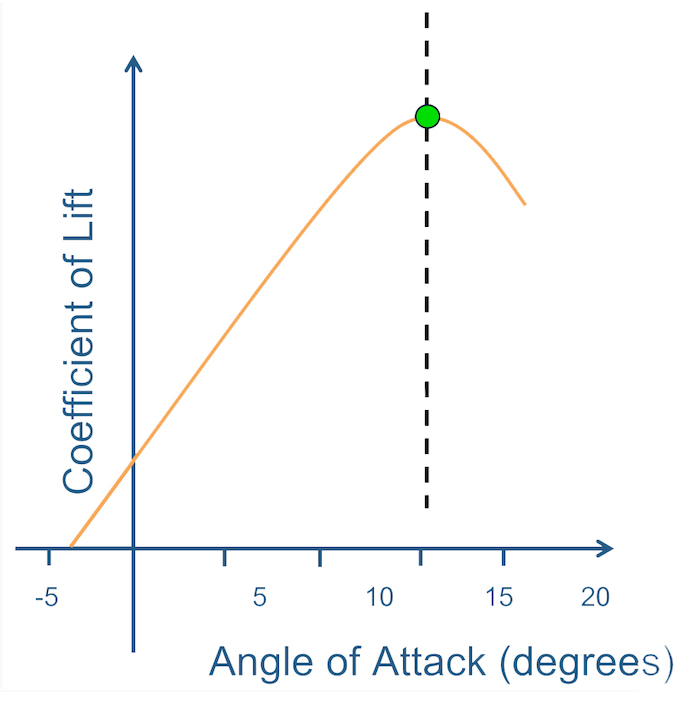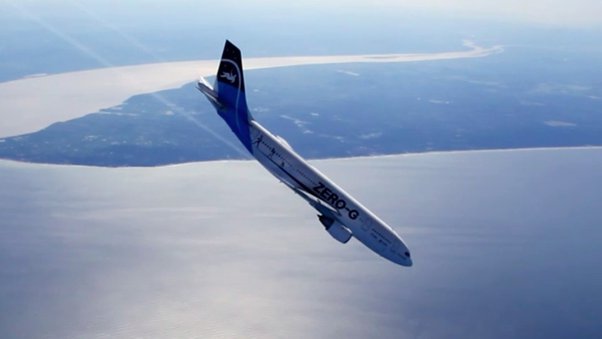When initiating recommended airplane upset recovery techniques, the first two techniques are:
How would you call the green point in the below schematic?

The critical angle of attack is the AOA at which the wing produces the highest coefficient of lift (CL). in other words, the wing is producing lift at its maximum efficiency. An increase of AOA beyond this point results in a rapidly decreasing CL. The wing is unable to keep smooth air flow on top of the wing, causing a significant loss of lift. This condition is defined as a stall. The critical AOA increases significantly when slats are extended and it decreases when trailing edge devices (flaps and ailerons) are extended.
Speedbrakes decrease lift, increase drag and can also decrease critical AOA.
It can also INCREASE critical AOA.
Which of the following is the most important key for avoidance of stalls and upset conditions?
At a high Mach number, the aircraft will stall at a:
During recovery from a nose-low, high-bank angle airplane upset:
It may be necessary to unload the airplane by decreasing backpressure to improve roll effectiveness. If the airplane has exceeded 90 deg of bank, it may feel like “pushing” in order to unload. It is necessary to unload to improve roll control and to prevent pointing the lift vector towards the ground. Full aileron and spoiler input may be necessary to smoothly establish a recovery roll rate toward the nearest horizon. It is important that positive g force not be increased or that nose-up elevator or stabilizer trim be used until the airplane approaches wings level.
Aft center of gravity (CG):

Which of the following statements regarding energy is true?
It is critically important to note that the only way to recover from a stall is to reduce AOA.
A stalled condition can exist at any altitude and airspeed, and may be recognized by continuous stall warning activation accompanied by at least on the following: buffeting, lack of pitch and/or roll authority and an inability to stop a descent rate.

Advertisement
With insufficient aerodynamic forces acting on the airplane (airplane stalled), its trajectory will be mostly ballistic and it may be difficult for the pilot to command a change in attitude until:
During recovery from a nose-low, wings-level, high-airspeed airplane upset:
Stability in the vertical axis tends to drive the sideslip angle toward zero. The most dynamic stability about the vertical axis on modern jet transports is from:
Lift is a function of:
Which of the following is not a stall warning device?
AOA is the delta between pitch attitude and the _____
A 60-degree bank angle will have a load factor of _____
1/cos(alpha) = g forces. At 60 degrees 1/cos(60) = 2G. At 45 degrees, the load factor is +1.41G, and at 60 degrees angle of bank the load factor is doubled to +2G
Rudders on modern jet transport airplanes are usually designed and sized to:
It is important to keep in mind that the rudders on modern jet transport airplanes are usually sized to counter the yawing moment associated with an engine failure at very low takeoff speeds. This very powerful rudder is also capable of generating large sideslips (when an engine is not failed). The large sideslip angles generate large rolling moments that require significant lateral control input to stop the airplane from rolling.
The predominant number of airplanes upsets are caused by:
Dihedral is the positive angle formed between the lateral axis of an airplane and a line that passes through the center of the wing. Which of the following statements is incorrect?
Dihedral contributes to the lateral stability of an airplane, and commercial jet transport airplanes are certificated to exhibit static lateral stability. A wing with dihedral will develop stable rolling moments with sideslip. If the relative wind comes from the side, the wing into the wind is subject to an increase in lift. The wing away from the wind is subject to a decrease in angle of attack and develops a decrease in lift. The changes in lift effect a rolling moment, tending to raise the windward wing; hence, dihedral contributes a stable roll due to sideslip. Since wing dihedral is so powerful in producing lateral stability, it is used as a “common denominator term” of the lateral stability contribution of other airplane components, such as rudder and wing sweep. In other words, the term “dihedral effect” is used when describing the effects of wing sweep and rudder on lateral stability and control.
Advertisement
Which of the following statements regarding recovering from an airplane upset is correct?
When climbing from FL100 to FL400, the stall speed as indicated on the PFD:
A good analysis process of an airplane upset should include:
Most of the multiengine turbojet loss-of-control incidents that are caused by environmental factors are because of:
Wake turbulence is the leading cause of airplane upsets that are induced by the environment.
The _____ is an outcome in which the aircraft is unnecessarily placed in a compromising situation that poses an increased risk to safety.
Undesired aircraft states are defined as ‘flight crew-induced aircraft position or speed deviations, misapplication of flight controls, or incorrect systems configuration, associated with a reduction in margins of safety”. Undesired aircraft states that result from ineffective threat and/or error management may lead to compromising situations and reduce margins of safety in flight operations.
Aft CG improves fuel economy but it also reduces aircraft pitch stability and increases occurrence to upset.
Slats _____ the critical AOA.
During recovery from a nose-low, wings-level, high airspeed upset:
When recovering from a stall, recovering the pitch attitude abruptly may induce a secondary stall.
Secondary stalls are aerodynamically the same as ordinary stalls, in that the wing has exceeded the critical angle of attack, but they are usually caused by rapid control movements. When a pilot attempts to recover from a stall by only slightly lowering the nose and then rapidly pitching up, the angular momentum of the upward pitching motion may cause the airplane to exceed the critical angle of attack by an even larger margin than the original stall. This can lead to a situation called a deep stall, where a more dramatic nose-down pitching movement may be required in order to break the stall.
Large downward aileron deflections:
Advertisement
Which of the following statements is true?
Even in a nose-low, low-speed situation, the airplane may be stalled at a relatively low pitch. It is necessary to recover from the stall first. This may require nose-down elevator, which may not be intuitive. Once recovered from the stall, apply thrust. The nose must be returned to the desired pitch by applying nose-up elevator. Avoid a secondary stall, as indicated by stall warning or airplane buffet. Airplane limitations of g forces and airspeed must be respected.
An aircraft is stalled and passes through approximately FL370. The flight path angle is around -35 degrees. Thrust is set to TOGA. For recovery which pitch altitude would you roughly need to get below the critical AOA?

Which of the following is NOT true about critical Angle of Attack?

The angle of attack (AOA) is the angle at which the chord of an aircraft's wing meets the:

The chord is a straight line from the leading edge to the trailing edge.
While ready at high speed, what happens if Mach is allowed to increase?
Flight at very high Mach numbers puts the airplane in a region of reduced maneuvering envelope (closer to buffet boundaries). Many operators opt to fly at very high altitudes, because of air traffic control (ATC) and the greater efficiencies afforded there. Flight operations very close to buffet-limiting altitudes restrict the range of Mach numbers and load factors available for maneuvering. Pilots should become very familiar with the high-speed buffet boundaries of their airplane and the combinations of weights and altitudes at which they operate.
The leading cause of aviation accidents is:
Loss of control in flight (LOC-I) means a categorization of an accident or incident resulting from a deviation from the intended flight path.
There are 3 types of energy:
Which of the following statements is always true?
In a nose high upset, with underwing mounted engines:

Exceed the critical angle of attack and the surface will stall, and lift will decrease instead of increasing. This is true:
Advertisement
